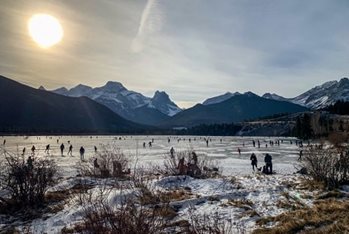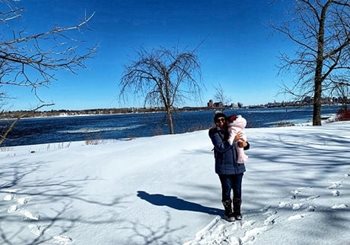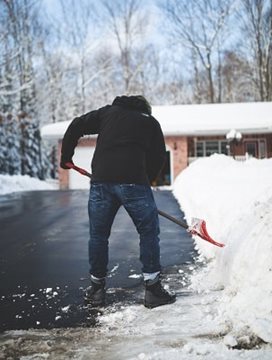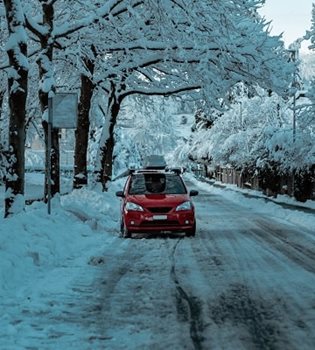In this series, newcomers will learn how to be better prepared for the risks and realities that come with Canadian winter. Discover practical tips for cold weather safety, first aid and emergencies like snowstorms and power outages.
 Getting out and about during winter is something that newcomers need to prepare for in advance. Breathtaking, frozen Canadian landscapes require special knowledge, skills and planning to navigate safely.
Getting out and about during winter is something that newcomers need to prepare for in advance. Breathtaking, frozen Canadian landscapes require special knowledge, skills and planning to navigate safely.Many classic wintertime activities involve being well prepared before getting started. The same is true for everyday chores like shovelling, moving along icy sidewalks, and driving on snow-covered roads.
“When ice and snow is all around us, injuries can easily occur around your home, on the street, or while driving,” explains Don Marentette, director of first aid programs at the Canadian Red Cross. “No matter how long you’ve lived in Canada, or how many winters you’ve experienced, it’s never a bad idea to refresh your prevention and preparedness knowledge before the cold weather sets in.”
Newcomers’ first-hand experiences with winter
Albina Ziatdinova of Immigrant Services Atlantic Canada (ISANS) supports newcomers as they prepare to immigrate to Canada. “We provide pre-arrival services and guidance to immigrants through a program called SOPA, and ISANS as an organization also offers post-arrival services and workshops for newcomers, including winter preparedness advice,” she says.“I highly encourage newcomers to reach out to local immigration support services, wherever they are in Canada, so that they can get access to important information they’ll need for starting a new life here,” Albina urges. “Winter is just one of many considerations to prepare for!”
Speaking from experience as a newcomer once herself, Albina can recall many times she injured herself when during the snowy season in Halifax, Nova Scotia.
 |
| Shurooq Almatarneh takes a safe, snowy walk with her daughter in Ottawa. |
“While I have been lucky that I didn’t get seriously injured because of winter storms here, I definitely hurt myself pretty badly while shovelling snow afterwards,” she admits. “If you have never shovelled snow before, I really encourage you to read up on safe winter snow clearing tips.”
Snowy shocks for newcomer family
Shurooq Almatarneh is an architect who came to Canada from Amman, Jordan. She and her family enjoy winter activities with their children in and around Ottawa, where they make their home.
“What surprised me the most about my first winter in Canada was that the snow never stopped drivers on the roads,” Shurooq remembers. “Life just keeps going here. In Jordan, a snow day is automatic day off for everyone.”
When it came to snow clearing, she didn’t realize just how much shovelling would be involved each winter.
“It can feel like it never ends. Shovelling snow around your property is a big job. It was shock, absolutely,” she recalls. “It also took me a few weeks during the winter to realize how much work it takes to clear and salt roads and sidewalks. And then, also, to fix the roads. The amazing efforts in Canada to keep everything open and operational during winter months really impressed me.”
 |
| Shurooq explores an ice castle with her son at Winterlude. |
“When there is a lot of snow and ice on the ground, to keep myself and my children safe when we go out, first I make sure we all have the right winter boots,” Shurooq says. ”We usually go walking, playing, visiting parks or to events like the Winterlude festival.”
She continues, “I try to avoid areas where the snow has not been cleaned or if there is black ice,” she adds. “We walk carefully. My husband Rabie and I pay attention to what is around us. Winter is exciting for the kids and we want to teach them how to be safe and careful.”
Prevention is key
“Prevention is key to navigating winter safely,” Don notes. “New Canadians can start their preparation by learning about practical prevention tips for navigating common winter situations that they’ll most likely experience. By knowing what to expect, people can be safer and feel more prepared for what they may encounter this winter.”
 |
| Photo Credit: Filip Mroz |
Shovelling snow safely
Shovelling heavy snow, frequently, throughout the winter months is a reality for all Canadians. This can be a shock to a newcomer as it is a lot of work and can sometimes require assistance.
After a storm or multiple days of snowfall, getting out the house and into your car can feel like a giant production. Shovelling snow takes a lot of physical effort and during this season, sprains, strains and injuries are frequent complaints.
Safe snow clearing tips:
- Stretch before shovelling or snow clearing around your property
- Lift carefully – don’t overload your shovel with snow and bend your knees when lifting and emptying your shovel
- Pace yourself for repetitive actions and change position often, to avoid unnecessary bone, muscle and joint injuries
- Stay hydrated and limit heavy loads to reduce your risk of painful muscle cramps
- Avoid overexertion and take breaks often. Learn how to recognize the signs and symptoms of a heart attack
- Rushing to clear snow can lead to injury. Plan in advance by watching the weather and giving yourself plenty of time to shovel your way out of your home and get your vehicle operational.
- Use salt to break ice on surfaces like outdoor entrance areas, steps, patios, ramps and driveway. This helps melt ice faster and reduces the amount of physical effort you will need to use.
 |
| Photo Credit: Kajetan Sumila |
Safe driving on winter roads
Black ice, snow-covered highways and freezing rain are just some of the conditions new Canadians can expect when driving in winter here.
Every year, winter weather is a factor in thousands of preventable motor vehicle collisions. Having the right equipment for your vehicle is as important as knowing defensive driving skills and adjusting to road conditions for Safe Winter Driving.
Winter driving tips:
- Take care of all seasonal vehicle maintenance in the fall, including a full set of winter. Check tire air pressure often, as it decreases in cold weather
- Use a snow brush and ice scraper to properly clean your vehicle’s windows, lights, mirrors, and roof
- Keep your vehicle stocked with emergency supplies like a first aid kit, flashlight, blanket, small shovel, and more. Learn how to prepare an emergency car kit
- Keep your gas tank at least half-full at all times in winter and carry a fully-charged mobile phone or battery pack. Don’t use your phone while driving unless your device is hands-free
- Check the weather before you drive. Avoid driving in bad weather whenever possible, especially if visibility and road conditions are poor. Never pass a snow plow – it’s extremely dangerous
- Reduce your speed and leave plenty of distance between your vehicle and the one in front of you. Allow extra time to travel to your destination and take your time to safely change lanes and make turns. Avoid abrupt turns or stops on winter roads
 |
| Photo Credit: Thom Holme |
Navigating slippery streets and pathways
Throughout the winter season, Canadians set out on snowy streets, sidewalks and other frequently-travelled routes.Stairs and entrances to homes and buildings, park trails, accessible ramps, and wet floors can also be tricky to navigate safely.
Add freezing rain, changing temperatures, frequent precipitation, and periods without snow clearing, and the paths we travel can feel like an obstacle course.
Snow-covered paths and icy surfaces are all-too-common hazards for slip and fall incidents that can result in concussions, sprains, strains, fractures and breaks.
Safe sidewalk navigation tips:
- Check the forecast to know how to dress and to plan your route. Choose appropriate winter gear for changing conditions. Avoid hills and areas known for ice build-up, if you can. Keep an eye on vehicles when using crosswalks – some drivers may have trouble stopping if the area is icy.
- To avoid a painful slip and fall, don’t rush. Take small steps, keep your head up and don’t lean forward. To keep your balance, take your hands out of your pockets. Point your toes out slightly to make yourself more stable on icy paths. Move carefully on snow-covered surfaces and sidewalks. Choose well-cleared paths where snow has been removed, or find path around the snow or ice when you can. Avoid shortcuts that have not been cleared.
- Take extra care on stairs, ramps and building entrances and exits where snow may have drifted or ice may have formed. Use available handrails and don’t forget to give people around you space to safely navigate, too.
- Be aware of your surroundings Don’t text as you go. Stay alert for any hazards and activity around you and up ahead as you approach. Assume that all wet, dark areas on the ground may be slippery or icy.
- If you are a transit user, dress warmly for waiting at outdoor stops. Check the transit schedule for delays and service interruptions before you begin each journey. Take care entering and exiting buses, as snowbanks and ice can be present and make it difficult to get on or off the bus.
Take care this winter, whatever path you choose
Navigating Canada’s winter landscape takes extra care, some advanced planning and an adventurous spirit. By taking time to slow down, learn about new weather conditions, prepare for emergencies, and develop safe navigating skills, newcomers will be well equipped for a first winter here, and many more to come!
Stay tuned for Part 4 of our Welcome to Canadian winter series, coming soon! Next time, we focus on helping newcomers learn about emergency planning and prevention before a winter storm arrives.
Are you a newcomer to Canada and want to learn first aid? Sign up for our First Aid Basics Workshop.
Download the free, interactive First Aid App to keep practical winter first aid tips in your pocket.
Related stories:

